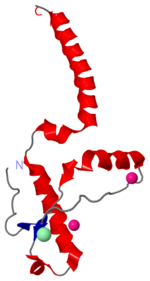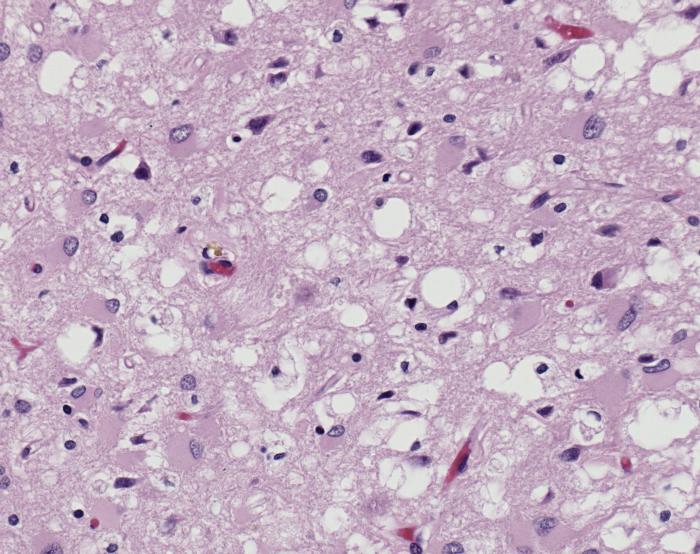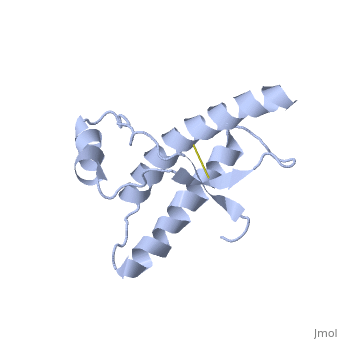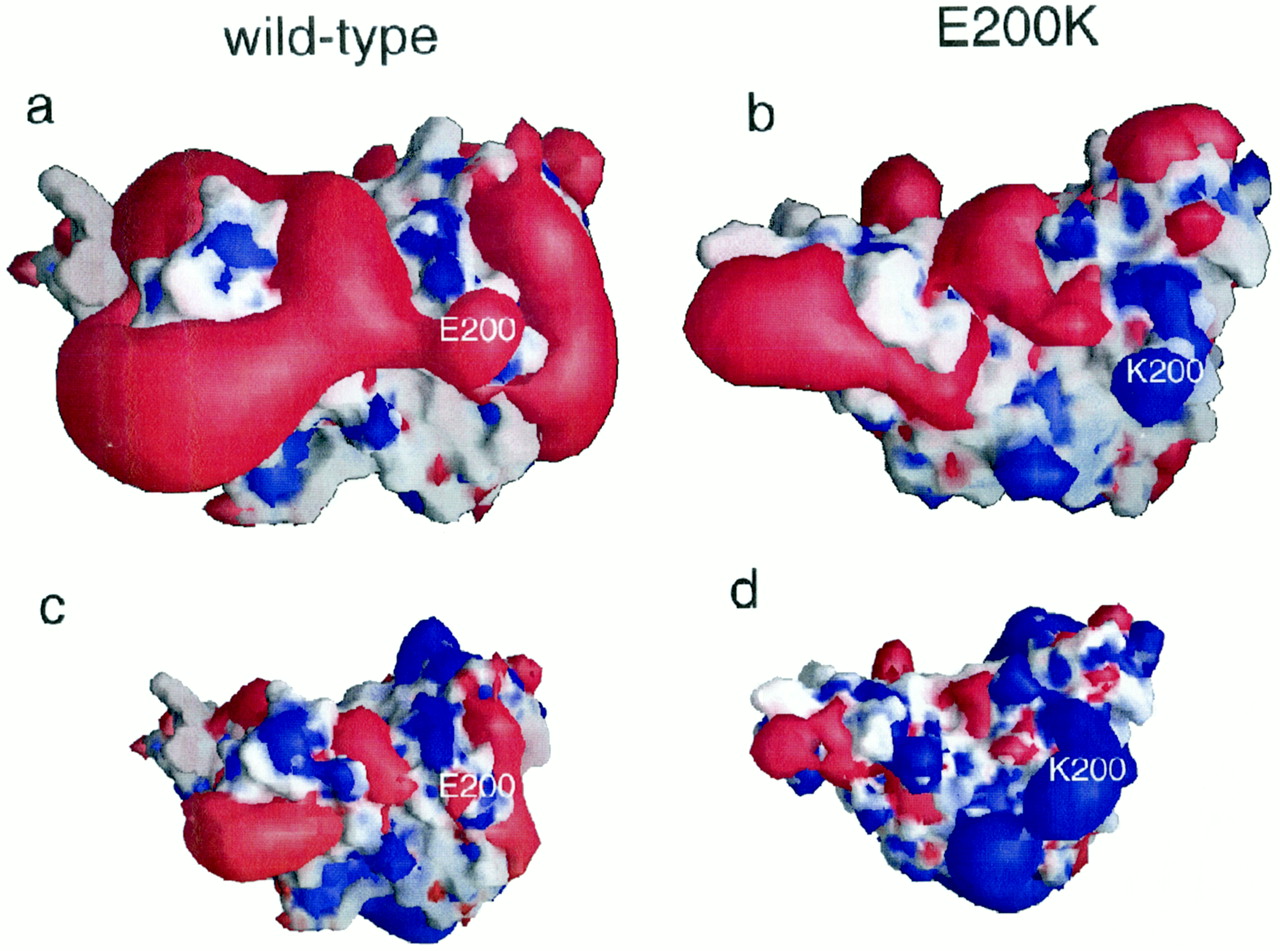User:Erin May/Sandbox 1
From Proteopedia
(→Prions as a disease causing agent) |
|||
| (10 intermediate revisions not shown.) | |||
| Line 8: | Line 8: | ||
[http://en.wikipedia.org/wiki/Prion Prions] are infectious or genetically coded misfolded proteins which act as templates upon which properly folded prion protein monomers can aggregate. Prions contain no nucleic acid such as other infectoius molecules or organisms. Human Prion Protein or Major Prion protein, exists as a normal constituent of human cells, found mostly in the brain<ref>Centers for Disease Control and Prevention: Prions. http://www.cdc.gov/ncidod/dvrd/prions/</ref> and is called PrP<sup>C</sup>.<ref name="Prusiner">PMID:9811807</ref> PrP<sup>C</sup> is composed of mostly helix whereas the infectious form, PrP<sup>Sc</sup> (also known as "scrapie" form), is composed of high percentage beta sheets.<ref name="Prusiner">PMID:9811807</ref> | [http://en.wikipedia.org/wiki/Prion Prions] are infectious or genetically coded misfolded proteins which act as templates upon which properly folded prion protein monomers can aggregate. Prions contain no nucleic acid such as other infectoius molecules or organisms. Human Prion Protein or Major Prion protein, exists as a normal constituent of human cells, found mostly in the brain<ref>Centers for Disease Control and Prevention: Prions. http://www.cdc.gov/ncidod/dvrd/prions/</ref> and is called PrP<sup>C</sup>.<ref name="Prusiner">PMID:9811807</ref> PrP<sup>C</sup> is composed of mostly helix whereas the infectious form, PrP<sup>Sc</sup> (also known as "scrapie" form), is composed of high percentage beta sheets.<ref name="Prusiner">PMID:9811807</ref> | ||
| - | The diseases prions confer are neurodegenerative disorders which result from the large scale aggregation of these proteins. This "bubbles" of protein aggregates appear clear on a pictomicrograph and resemble a sponge. Bovine Spongiform Encephalopathy(BSE), or Mad Cow Disease, is a form of Transmissible | + | The diseases prions confer are neurodegenerative disorders which result from the large scale aggregation of these proteins. This "bubbles" of protein aggregates appear clear on a pictomicrograph and resemble a sponge. Bovine Spongiform Encephalopathy(BSE), or Mad Cow Disease, is a form of Transmissible Spongiform Encephalopathy caused by ingesting bovine prions. The first known cases of BSE occurred in the 1970's and have garnered a lot of media attention. Recently, feed bans in the United States and Canada have been adopted by the government in an attempt to stop the spread of BSE between cows. This bans the use of potential materials which would contain prion proteins, whether misfolded or wild-type. <ref>Centers for Disease Control and Prevention: Bovine Spongiform Encephalopathy. http://www.cdc.gov/ncidod/dvrd/bse/index.htm</ref> For more information about the infections related to prions see [http://en.wikipedia.org/wiki/Transmissible_spongiform_encephalopathy Transmissible spongiform encephalopathy at Wikipedia]. |
== Unfolding Mechanism == | == Unfolding Mechanism == | ||
| Line 20: | Line 20: | ||
The following residue alterations confer increased susceptibility to the unfolding of these alpha helices characteristic of spongiform encephalopathies. | The following residue alterations confer increased susceptibility to the unfolding of these alpha helices characteristic of spongiform encephalopathies. | ||
| - | Residue 129 Val-->Met confers increased susceptibility to contracting spongiform encephalopathies. The alteration from 129 valine to 129 methionine does not change as both are hydrophobic. The methionine group is bulkier however. Due to the limitations of viewing the monomeric form, <scene name='User:Erin_May/Sandbox_1/Methionine_129/1'>Methionine 129</scene>, does not offer a possible mechanism of unfolding or aggregation. This single residue, however has incredible actions. As of January 2010, only individuals with homozygous Metionine 129 had been diagnosed with infectious Creutzfeldt–Jakob disease. | + | Residue 129 Val-->Met confers increased susceptibility to contracting spongiform encephalopathies. The alteration from 129 valine to 129 methionine does not majorly change electrostatics as both are hydrophobic. The methionine group is bulkier however. Due to the limitations of viewing the monomeric form, <scene name='User:Erin_May/Sandbox_1/Methionine_129/1'>Methionine 129</scene>, does not offer a possible mechanism of unfolding or aggregation. This single residue, however has incredible actions. As of January 2010, only individuals with homozygous Metionine 129 had been diagnosed with infectious Creutzfeldt–Jakob disease.<ref name="Lee">PMID:19927125</ref> |
<scene name='User:Erin_May/Sandbox_1/Species_variable_domain/1'>Residues 164 to 170</scene> exhibit species specific residues. This region is most variable between species. Residue shifts in this section increase or decrease susceptibility from inter-species transmission of TSE's. The more similar this region is between species, the more likely each are able to transfer infectious prions between the two.<ref name="Lee">PMID:19927125</ref> | <scene name='User:Erin_May/Sandbox_1/Species_variable_domain/1'>Residues 164 to 170</scene> exhibit species specific residues. This region is most variable between species. Residue shifts in this section increase or decrease susceptibility from inter-species transmission of TSE's. The more similar this region is between species, the more likely each are able to transfer infectious prions between the two.<ref name="Lee">PMID:19927125</ref> | ||
| Line 49: | Line 49: | ||
The following residues are not visible in the PrP<sup>Sc</sup> shown. These residues are not part of the beta sheets of the unraveled prion protein, yet they are important to the transference of TSEs. The dimer form of Human Prion Protein shows where these residues make their influence: | The following residues are not visible in the PrP<sup>Sc</sup> shown. These residues are not part of the beta sheets of the unraveled prion protein, yet they are important to the transference of TSEs. The dimer form of Human Prion Protein shows where these residues make their influence: | ||
| - | 129 Val-->Met (susceptibility to Creutzfeldt–Jakob disease). | + | 129 Val-->Met (susceptibility to Creutzfeldt–Jakob disease). Residues R164 to S170 (variable region between species)<ref name="Lee">PMID:19927125</ref> |
| - | + | ||
| - | Residues R164 to S170 (variable region between species)<ref name="Lee">PMID:19927125</ref> | + | |
200 Glu-->Lys (present in infectious and spontaneous form of Creutzfeldt–Jakob disease)<ref name="Zhang">PMID:10954699</ref> | 200 Glu-->Lys (present in infectious and spontaneous form of Creutzfeldt–Jakob disease)<ref name="Zhang">PMID:10954699</ref> | ||
| Line 61: | Line 59: | ||
===Dimer Form=== | ===Dimer Form=== | ||
| - | <StructureSection load='1i4m' size='300' side='left' caption='Major Prion Protein: Dimerized [[ | + | <StructureSection load='1i4m' size='300' side='left' caption='Major Prion Protein: Dimerized [[1i4m]]' scene=''> |
The <scene name='User:Erin_May/Sandbox_1/Previously_shown_residues/1'>residues</scene>, shown above, alter the function of Major Prion Protein's ability to re-fold, however their positions on the wild-type monomer and fully unfolded PrP<sup>Sc</sup>, do not illustrate a clear mechanism for propagation. The dimer brings light to these residues influence on the infectious qualities of the disease causing residues. | The <scene name='User:Erin_May/Sandbox_1/Previously_shown_residues/1'>residues</scene>, shown above, alter the function of Major Prion Protein's ability to re-fold, however their positions on the wild-type monomer and fully unfolded PrP<sup>Sc</sup>, do not illustrate a clear mechanism for propagation. The dimer brings light to these residues influence on the infectious qualities of the disease causing residues. | ||
| Line 69: | Line 67: | ||
The following interactions and residue switching portray possible catalytic sites: | The following interactions and residue switching portray possible catalytic sites: | ||
| - | Residues 129, 200, and 164 to 170 are shown to exist right at the dimer interfaces (as noted in the previous structures). The location of these residues within the dimer indicates that their key operation is found somewhere in the dimerization process. | + | Residues 129, 200, and 164 to 170 are shown to exist right at the dimer interfaces (as noted in the previous structures). The location of these residues within the dimer indicates that their key operation is found somewhere in the dimerization process. <ref name="Lee">PMID:19927125</ref><ref name="Knaus">PMID:11524679</ref><ref name="Zhang">PMID:10954699</ref> |
Helix 1 (Ser 143−Tyr 157) exists at the <scene name='User:Erin_May/Sandbox_1/Nonpolar_at_dimer_interface/2'>dimer interface</scene>. Many nonpolar residues form Van der Waals attractions. Acidic and mostly negative residues are shown in blue. Basic and mostly positive residues are shown in red. The interactions between these also stabilize the dimer interface. | Helix 1 (Ser 143−Tyr 157) exists at the <scene name='User:Erin_May/Sandbox_1/Nonpolar_at_dimer_interface/2'>dimer interface</scene>. Many nonpolar residues form Van der Waals attractions. Acidic and mostly negative residues are shown in blue. Basic and mostly positive residues are shown in red. The interactions between these also stabilize the dimer interface. | ||
| Line 79: | Line 77: | ||
More Van der Waals and electrostatic forces occur between the <scene name='User:Erin_May/Sandbox_1/Switch-helix_1_interactions/1'>switch region and helix 1</scene> of the same molecule. These interactions would not be able to occur in the monomer. | More Van der Waals and electrostatic forces occur between the <scene name='User:Erin_May/Sandbox_1/Switch-helix_1_interactions/1'>switch region and helix 1</scene> of the same molecule. These interactions would not be able to occur in the monomer. | ||
| - | + | <scene name='User:Erin_May/Sandbox_1/Interface_hydrogen_bonding/1'>Dimer interface hydrogen bonding</scene> between the dimers exist at Thr188 O−Gly195 N, Thr190 O−Lys194 N and Thr192 O−Thr192 N | |
<scene name='User:Erin_May/Sandbox_1/Hydrogen_bond_asp_202/1'>Hydrogen bonding</scene> between Asp 202 and Thr 199 stabilize the dimeric structure. | <scene name='User:Erin_May/Sandbox_1/Hydrogen_bond_asp_202/1'>Hydrogen bonding</scene> between Asp 202 and Thr 199 stabilize the dimeric structure. | ||
| - | Arg 220 hydrogen | + | <scene name='User:Erin_May/Sandbox_1/Hydrogen_bonding/1'>Arg 220 and Ser 132</scene> form a hydrogen bond located at the end of helix 3 and near the switch region of the other chain, which allow the inter-chain interactions to be specific. |
Due to the importance of initial dimerization in the formation of prion aggregates, the step of dimerization presents a known step for treatments to target.<ref name="Knaus">PMID:11524679</ref> | Due to the importance of initial dimerization in the formation of prion aggregates, the step of dimerization presents a known step for treatments to target.<ref name="Knaus">PMID:11524679</ref> | ||
Current revision
Contents |
Prions as a disease causing agent


Prions are infectious or genetically coded misfolded proteins which act as templates upon which properly folded prion protein monomers can aggregate. Prions contain no nucleic acid such as other infectoius molecules or organisms. Human Prion Protein or Major Prion protein, exists as a normal constituent of human cells, found mostly in the brain[2] and is called PrPC.[3] PrPC is composed of mostly helix whereas the infectious form, PrPSc (also known as "scrapie" form), is composed of high percentage beta sheets.[3]
The diseases prions confer are neurodegenerative disorders which result from the large scale aggregation of these proteins. This "bubbles" of protein aggregates appear clear on a pictomicrograph and resemble a sponge. Bovine Spongiform Encephalopathy(BSE), or Mad Cow Disease, is a form of Transmissible Spongiform Encephalopathy caused by ingesting bovine prions. The first known cases of BSE occurred in the 1970's and have garnered a lot of media attention. Recently, feed bans in the United States and Canada have been adopted by the government in an attempt to stop the spread of BSE between cows. This bans the use of potential materials which would contain prion proteins, whether misfolded or wild-type. [4] For more information about the infections related to prions see Transmissible spongiform encephalopathy at Wikipedia.
Unfolding Mechanism
Currently, the mechanism by which a template prion unfolds a the helices of a properly folded prion protein is unknown. Specific residues have been shown to either confer resistance or lend themselves to this unfolding.
PrPC natural monomer
| |||||||||||
PrPSc
| |||||||||||
Dimer Form
| |||||||||||
Reference List
- ↑ Image of Creutzfeldt-Jakob positive brain tissue was obtained from The CDC's Public Health Image Library.
- ↑ Centers for Disease Control and Prevention: Prions. http://www.cdc.gov/ncidod/dvrd/prions/
- ↑ 3.0 3.1 Prusiner SB. Prions. Proc Natl Acad Sci U S A. 1998 Nov 10;95(23):13363-83. PMID:9811807
- ↑ Centers for Disease Control and Prevention: Bovine Spongiform Encephalopathy. http://www.cdc.gov/ncidod/dvrd/bse/index.htm
- ↑ 5.0 5.1 5.2 5.3 Lee S, Antony L, Hartmann R, Knaus KJ, Surewicz K, Surewicz WK, Yee VC. Conformational diversity in prion protein variants influences intermolecular beta-sheet formation. EMBO J. 2010 Jan 6;29(1):251-62. Epub 2009 Nov 19. PMID:19927125 doi:10.1038/emboj.2009.333
- ↑ 6.0 6.1 6.2 6.3 6.4 Knaus KJ, Morillas M, Swietnicki W, Malone M, Surewicz WK, Yee VC. Crystal structure of the human prion protein reveals a mechanism for oligomerization. Nat Struct Biol. 2001 Sep;8(9):770-4. PMID:11524679 doi:10.1038/nsb0901-770
- ↑ 7.0 7.1 7.2 7.3 Zhang Y, Swietnicki W, Zagorski MG, Surewicz WK, Sonnichsen FD. Solution structure of the E200K variant of human prion protein. Implications for the mechanism of pathogenesis in familial prion diseases. J Biol Chem. 2000 Oct 27;275(43):33650-4. PMID:10954699 doi:10.1074/jbc.C000483200


